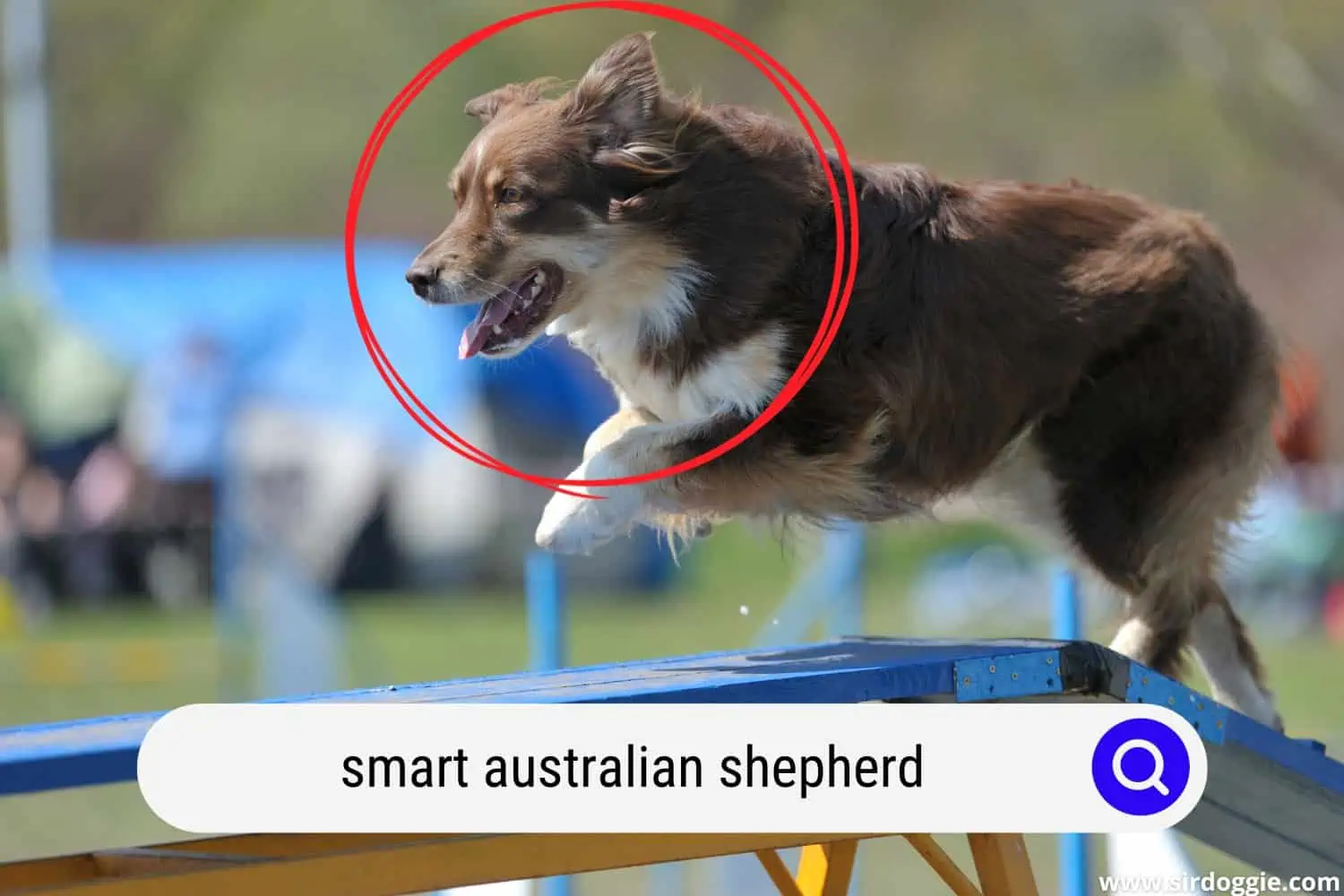How Smart is an Australian Shepherd?
The Australian Shepherd has often been characterized as intelligent and focused and is a popular breed for agility and flyball sports, as well as for herding trials and obedience competitions. This breed is very affectionate and devoted, and these pups have a strong herding instinct that may occasionally reveal itself in herding family members and other dogs. Since these dogs are popular for agility and obedience trials, breed enthusiasts argue that they are extremely intelligent and easy to train.

How smart is an Australian Shepherd? Australian Shepherds are considered to be very smart and are ranked 42nd out of 137 breeds for obedience and working intelligence. Noted psychologist, dog expert, and author, Stanley Coren, ranks Australian Shepherds as “average” intelligence, but he says that this breed makes up its average rating with very high instinctive and adaptive intelligence. Although some critics are skeptical of Cohen’s ranking of the Australian Shepherd, it is well known in the dog community that Australian Shepherds are pretty smart.
So How Smart is an Australian Shepherd?
As mentioned above, Australian Shepherds are very smart, and just like people and other animals, they possess several kinds of intelligence that make them unique. In Cohen’s book, he lists several kinds of intelligence in dogs, and these include instinctive intelligence, adaptive intelligence, and working and obedience intelligence.
Instinctive intelligence
Instinctive intelligence refers to the intelligence that a dog was initially bred for. For example, Australian Shepherds are herding dogs, and they were bred to herd animals. They have an instinctive ability to round up animals, keep them together in a group, and move them in a specific direction such as into a pen or corral. Herding dogs need only minimal human intervention when doing their thing.
Different breeds are said to have different types of instinctive intelligence. For example, a Doberman trained as a guard dog will watch over things, Hound dogs are bred to sniff and track, Dachshunds are bred to go after rodents, Labrador Retrievers are bred to fetch and retrieve items, and German Shorthair Pointers are bred to sniff out birds and point out their locations. In contrast, companion dogs such as Shih Tzus and Pugs are tuned into human social signals and emotions, and that makes them good at offering comfort and support.
Instinctive intelligence is tied to breeding and genetics, so it is difficult to compare the intelligence of different breeds without taking into account their breeding. For example, a Border Collie who wins a blue ribbon for herding sheep is not necessarily smarter than the Chihuahua who loves to sit on your lap. When we look at how smart Australian Shepherds are, it’s important to keep breeding in mind.
Adaptive Intelligence
Another dimension of dog intelligence is something called adaptive intelligence. This involves what a dog can learn to do alone without any training. It is about learning from experience and solving new problems. Adaptive intelligence is different from instinctive intelligence because it can differ among dogs of the same breed.
For example, you may have an exceptionally smart German Shepherd who may learn that a snake is a bad thing after just one encounter and another German Shepherd who won’t learn the first time and tangle with a rattlesnake more than once. Some dogs may make the same mistake over and over, and others not. Adaptive intelligence is very individual, and not necessarily tied to breeding.
When people think of smart dogs, many may think of police dogs, guide dogs, assistance, or therapy dogs. Assistance dogs are trained in certain tasks, but they are selected based on their adaptive intelligence. These dogs need to work through complex tasks such as knowing when to cross a busy street, or how to open a refrigerator door. This kind of intelligence involves problem-solving and learning and varies from dog to dog.
Australian Shepherds rank very high in adaptive intelligence, and they can learn quickly from past experiences and are very capable of problem-solving.
Working and Obedience Intelligence
The third type of intelligence is called working and obedience. When a dog demonstrates that she understands a particular command, she shows working intelligence. For example, if your dog responds to the “sit” command, she is illustrating a sort of intelligence related to a particular command, which is often rewarded with a treat or positive reinforcement.
It makes sense that dogs are willing to respond to human instruction, especially if they have a reward. It is the closest to what we might call school-learning ability and is based on what the dog can learn to do when instructed by humans.
Although intelligence comes in different forms, and ways of measuring intelligence in dogs are still in their infancy, one thing is for sure: Australian Shepherds are quite intelligent and versatile, making them a popular choice for agility, herding, and obedience events.
FAQs
Do Australian Shepherd Dogs Come From Australia?
Believe it or not, Australian Shepherd dogs do not come from Australia. This breed was first developed in the Western US in the 19th Century as a livestock herding dog and is descended from Basque working dogs from the Pyrenees in southern France and northern Spain.
Australian Shepherds are considered a medium-sized breed, built for long hours of activity and running through all sorts of terrain. The average lifespan for an Australian Shepherd is 13-15 years, and they come in several colors ranging from red merle, blue merle, red, and black, with white area or white markings.
Are Australian Shepherds Good Family Dogs?
Australian Shepherds make great family dogs because they are bred to be loyal, and generally, get along with other animals. They can be wary of strangers and may tend to protect young children by herding them and keeping them together. So if you have young children, keep this in mind; your Aussie may just be doing her job. Australian Shepherds are easy-going and love to play and run, and can be a wonderful addition to any family.
Are Australian Shepherds Good at Agility?
Australian Shepherds excel at agility and obedience trials. For example, in 2016, Holster, a 6-year-old Australian Shepherd, won the Westminster Agility Championship, making him one of the most famous agility dogs in the world. Although Australian Shepherd dogs were bred to herd livestock, they make fantastic agility athletes and for a medium-sized dog, they can never cease to amaze us with their speed and intelligence.

Do Australian Shepherds Need Lots of Exercises?
Australian Shepherds are a high-energy breed, which makes sense for a herding dog. Herding dogs need to have speed, intelligence, and stamina, and the Aussie dogs possess all these traits. Australian Shepherds do require exercise daily and should be able to have free range in a fenced-in yard or be able to run and romp for an hour or two daily.
Aussie dogs are loyal companions and love to go on long walks and hikes, and once they are full-grown, they can make wonderful running buddies. In addition to exercise, it’s also important to keep your Aussie’s mind occupied and entertained by playing games or providing enrichment toys and activities.

Family Dog Expert Author
Hi there! I’m Stuart, a devoted dog lover and family dog expert with over a decade of experience working with our furry companions. My passion for dogs drives me to share my knowledge and expertise, helping families build strong, loving bonds with their four-legged friends. When I’m not writing for SirDoggie, you’ll find me hiking, playing with my beautiful dog, or studying music.